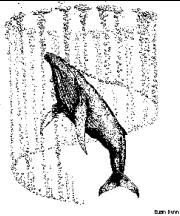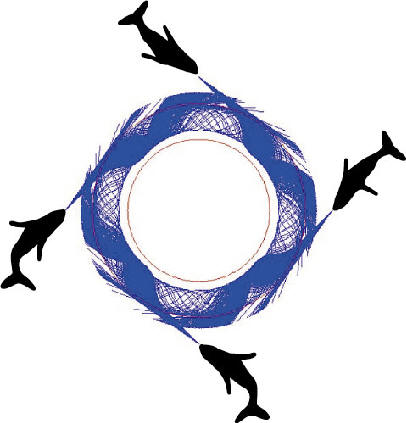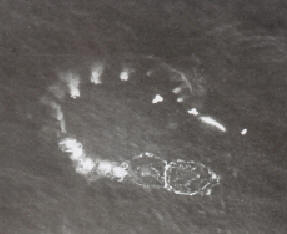| The acoustic effects of
the bubble nets of humpback whales
|
|
|
For the
homepage of the Centre Ultrasonics and Underwater Acoustics (UAUA),
click |
||||
 |
For decades people have speculated as to how the bubble nets of humpback whales trap fish. Several marine creatures use bubbles to catch prey, but those of the humpback whales are the most spectacular. One whale (or a group) produces a cylindrical wall of bubbles (Figure 1), the interior (up to 30 m diameter) being relatively bubble-free (Figure 2). Here shoals of fish congregate. Why these fish should refuse to swim through a wall of bubbles has been uncertain for decades. It is thought that a wall of bubble alone can contain some fish. However it is also known that, when they produce bubble nets, at least some humpback whales have developed an unusual 'feeding call'. A recent article by T. G. Leighton, S. D. Richards and P. R. White proposes that the acoustical interaction between these bubble nets and the feeding calls emitted by humpback whales might assist in trapping the prey (click here to hear a recording of the calls). Numerous such interactions exist. For example, one effect (which is described in more detail below) is that the sound could become trapped within the walls of the bubble net, making a 'wall of sound' which the prey are reluctant to cross. Another effect could arise if the whales emit sound into the bubble net from below: in this case, the cylinder might be made to reverberate, startling the fish and causing them to school into a tight group, forming a compact target for the whales to feed on. |
|
||
|
Figure 1: Schematic, courtesy of Cetacea.org |
Figure 2. Aerial view of bubble net (photograph by A. Brayton) | |||
|
The "Wall of Sound" Effect: If sound is directed at the bubble wall itself, various acoustic effects operate to make the interior of the net quiet. This quiet sanctuary may be the basis of a trapping mechanism. The natural schooling response of fish to the terrifying wall of sound which they encounter if they try to leave the trap makes them a compact meal when the whales rise up from beneath the trap, their mouths open. Indeed the intense sound of the feeding call, focused within the walls of the net, may generate swim bladder resonances to the detriment of the fish. Simple attenuation of the sound would cause its amplitude to drop as it propagates towards the centre of the net. For the bubble net in the original article, this attenuation would by a relatively mild 6 dB/m at the 4 kHz frequency found in the feeding calls of humpback whales. However it is very much greater at the >100 kHz which a dolphin might use for echolocation in the vicinity of the bubble net. However more fascinating still is the effect of refraction, as described in the original article. An extension of the work speculates to what extent other creatures might exploit bubble acoustics for feeding. This leads to the question of how it is that dolphin sonar might still be operational in bubbly environments (such as the net or the surf zone) where man-made sonar (which can deploy superior hardware) fails to perform. This topic is covered in Part (II).
References:
For radio interviews on this topic, click here.
Other sites featuring humpback bubble nets:
http://www.sfu.ca/biology/berg/whale/abcwhale.html http://students.ceid.upatras.gr/~pirli/whales/whales.html
Recording of humpback feeding call courtesy of F. Sharpe and L. Dill.
Page last updated by T. G. Leighton, 26 February 2004. © T G Leighton 2003
|
||||

